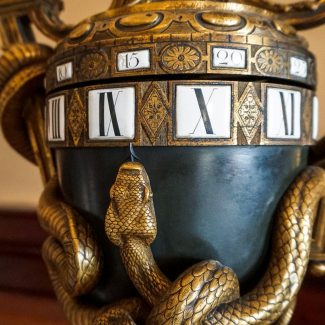The Urn Clock (circa 1770-1790) crafted by Unknown.
A rather ingenious piece of technology from the late 18th century, this clock is determined to remind one of the gift and impermanence of time, and the ease in which it is lost. The unknown maker and specific date of its creation only highlight further the ominous mystery of this truly intriguing piece.

The Urn Clock uses a static snakehead as an indicator of the hour, while the lid of the urn slowly turns over a twenty four hour period. Somewhat morbid in its design, as an urn is used to contain the ashes of the dead, here we have a clock shaped like an urn holding the ashes of time itself.
The cherubs below announce the roots of life, birth and life itself stemming from divine origin. It is as if the foundation of death is life itself, as death needs life in order to exist. If life is divine, it follows too that death would be also, as ordained, and as natural.
The more one looks at the serpents, the clearer it is they are waiting for the hour to strike, but fighting about who gets to strike. The race to death is a competition between natural and unnatural, entwined by their very nature. The snakes then become the inevitability of fate no matter if the hour is early or late, eventually, our time will come.
If the serpents are a tribute to the life of Louis XIV, his death, coinciding with the death of French monarchy itself, would make this piece appropriately themed. The question then becomes whether it was made before or after his death. This is something that can’t really be determined, since the possible dates of its creation and the documented death of Louis XIV create the possibility for both, though it must be said, estimations place its latest possible date (1790) at three years before.
Time moves on, death is forever there, but just as the day begins again, so too does life, and so eternity becomes the cycle of life, death and rebirth. The death of a monarchy, the birth of a republic, just as France experienced in the late 18th century.
